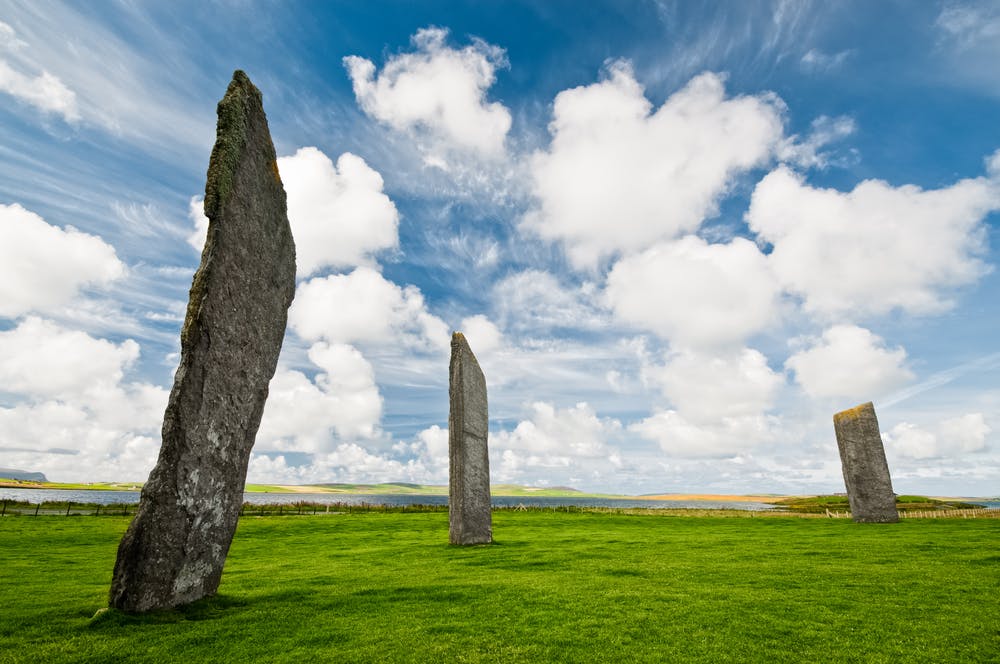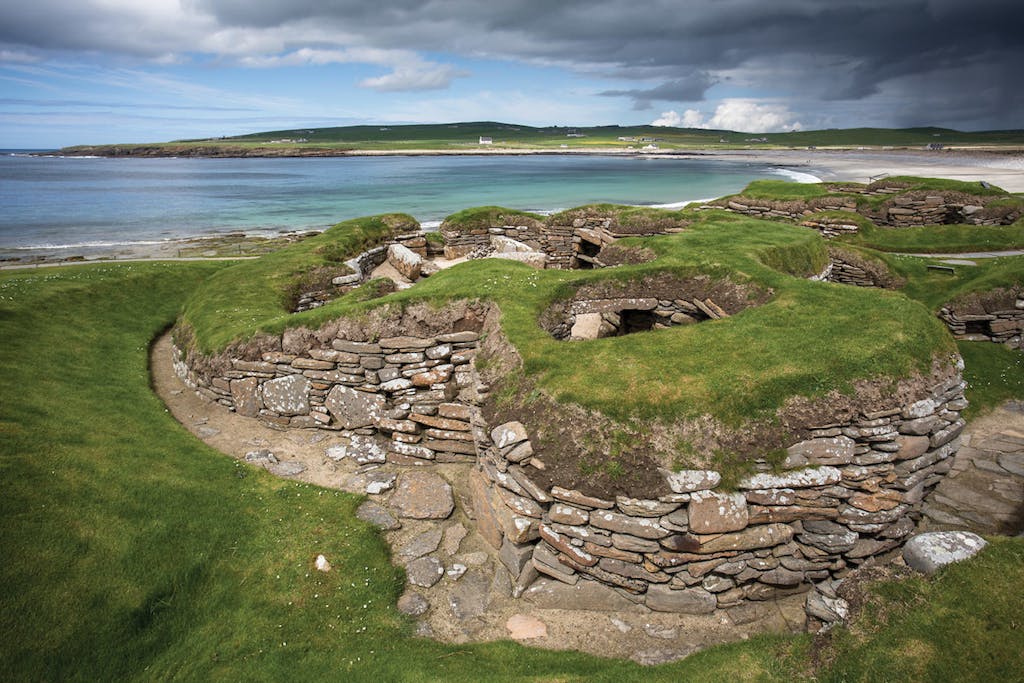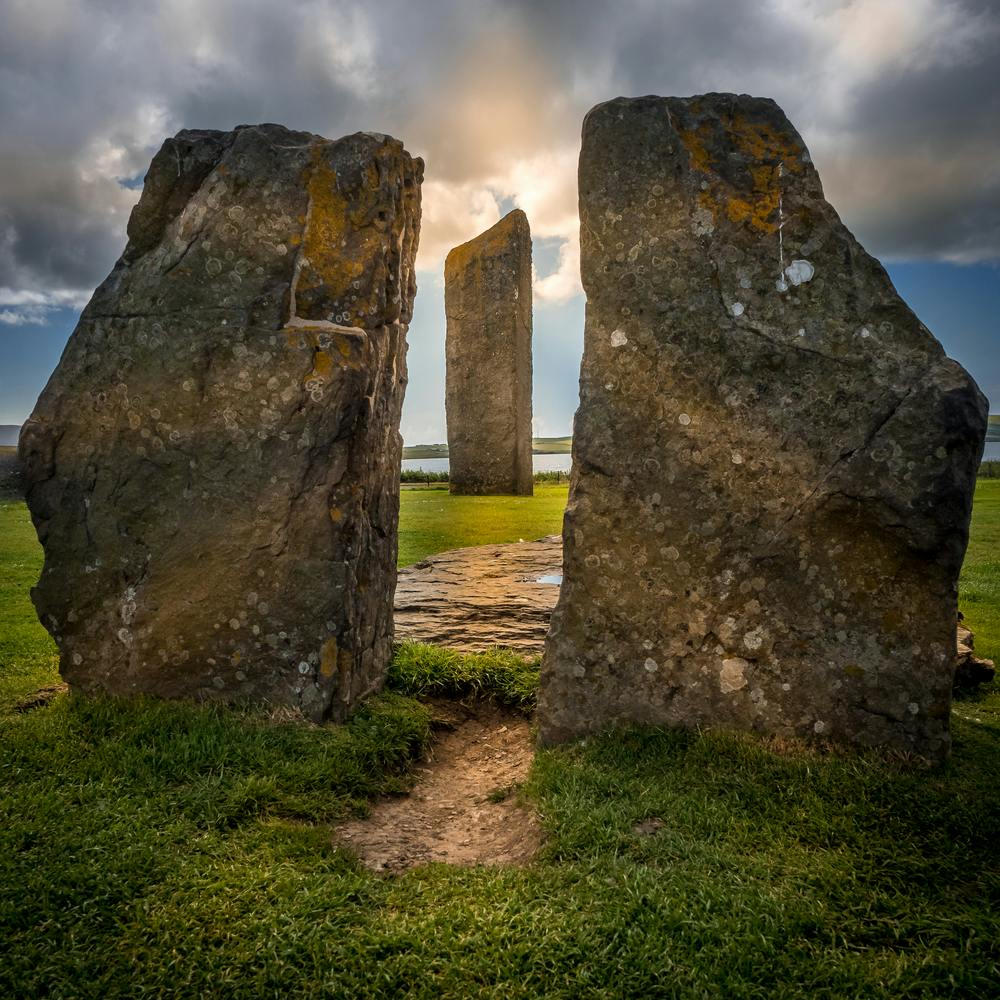In Scotland, Deciphering the Mysterious Standing Rocks of Stenness
A shaft of sunlight peeked through gray clouds, touching the edge of a massive stone slab; the sharp peak on its left pointing toward the sky. On the ground, a gang of wooly sheep, fleeces off-white and bedraggled by the rain, picked their way over the grass. They were seemingly oblivious to the magnitude of the four standing rocks I’d walked through the rain to see. Situated on flat land with views toward the hills of the neighboring island of Hoy, the Standing Stones of Stenness, is possibly the earliest henge (ceremonial enclosure) site in the British Isles.
The megaliths, which reach up to 19 feet high, are, according to Historic Environment Scotland, all that remains of a circle that once held 12 standing rocks. “Once” because, as is often the nature of ancient monuments, no one can determine precisely when they were erected. Therefore, experts have settled on a vague “over 5,000 years ago.”

The origin of the mysterious stones
There’s much we don’t know about the Standing Stones of Stenness, including their purpose, although it’s clear this was a place where people gathered. Perhaps the mystery is what draws people, like me on that wet winter morning, to the site located north of mainland Great Britain. The stones rise out of the fertile, low-lying land on the largest island, which is confusingly named Mainland and located in the Orkney archipelago.
Nevertheless, many have sought to unravel that mystery and posit their own theories about the purpose of the standing rocks. Sir Walter Scott on his 1814 visit declared, implausibly, the stone slab in the center to have been “probably once the altar on which human sacrifices were made.” More recent theories have speculated they were placed in alignment with the sun, moon and stars — an idea that makes them a popular gathering place on the winter solstice.
Excavations at the Ness of Brodgar
A five-minute walk down the road is the Ness of Brodgar. For the past decade and a half, archaeologists have spent each summer excavating this sprawling site that occupies the narrow isthmus between the Stones of Stenness and another Neolithic henge. It’s the Ring of Brodgar — a circle of 36 standing stones located less than a mile northwest. Both circle henges lie within the Heart of Neolithic Orkney UNESCO World Heritage Site, which also includes the Neolithic village Skara Brae and the chambered cairn Maeshowe.

The Ness, the remains of a cluster of stone buildings enclosed by a thick wall, is not officially part of the heritage site because archeologists discovered it three years after the UNESCO inscription. Excavations have revealed that the Ness was in use for more than a thousand years: built between 3,300 and 3,200 B.C. and abandoned by 2,000. That’s a period that overlaps with the other sites. The scale and complexity of the structures — likely built by a small farming community — tell us that it must have been a site of great importance. Supporting evidence lies in the elaborate details of the carved stonework, colored facades and slate roofs, as well as a rich collection of art and artifacts. The positioning of the two stone circles at either end hints at a grand link between them.
Unearthing the meaning of Orkney’s sites
People have long known that Orkney is home to an extraordinarily dense collection of some of the world’s most beautiful Neolithic monuments. But the discovery of the Ness has caused researchers to question the relationship between the sites around it and speculate whether they were all distinct parts of the same complex. It remains a mystery, but ongoing excavations can tell us that the people who built them were not only highly skilled engineers. “[They were] confident enough in themselves and their beliefs to dominate their landscape with these architectural statements,” says Anne Mitchell, Ness of Brodgar development project officer, “as the great medieval cathedrals of Europe dominate their places.”
What also seems certain is that this has long been a gathering or pilgrimage site. Most everyone who has occupied the island has been drawn here, from the Neolithic people to the Norse to modern-day visitors, like me, pulled toward a glimpse into the mysteries of the ancient world.

Curious to see the Stones of Stenness and other Neolithic sites for yourself? Explore Silversea’s Northern Europe & the British Isles itineraries to plan a visit.
